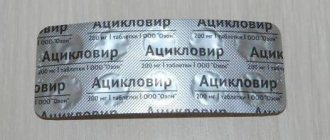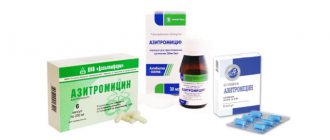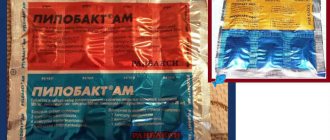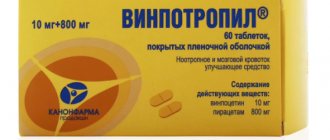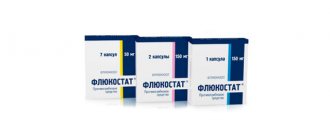Pharmacological properties of the drug Virolex Virolex tablets
Acyclovir is an antiviral drug active against herpes simplex virus types 1 and 2 and herpes zoster virus. Has a virostatic effect. Inhibits the synthesis of viral DNA without affecting the physiological processes in the cell. After oral administration, acyclovir is slowly and incompletely absorbed from the digestive tract. The maximum concentration in blood plasma is reached after 1.5–2 hours. The bioavailability of acyclovir is 13–21%. The half-life with unchanged renal function is 3.3 hours. Acyclovir easily penetrates into the tissues, organs and biological fluids of the body: the brain, kidneys, lungs, liver, muscles, spleen, uterus, vaginal mucosa, vaginal secretions, cerebrospinal fluid and contents herpetic blisters. 15.4% of acyclovir is bound to plasma proteins. In healthy individuals, acyclovir is excreted primarily in the urine. Pharmacokinetics in children over 1 year of age are similar to those in adults.
Side effects
Possible side effects when using Virolex:
- When taken orally: abdominal pain, nausea, diarrhea, vomiting, headache, skin rash, fever, dizziness, drowsiness or insomnia, hallucinations, fatigue, decreased concentration, rarely - transient increases in liver enzymes, creatinine, urea, concentration bilirubin in the blood, as well as hair loss, leukopenia, erythropenia, lymphocytopenia;
- With intravenous administration: nausea, vomiting, inflammation or phlebitis at the injection site, crystalluria, acute renal failure, encephalopathy, manifested by agitation, hallucinations, confusion, psychosis, drowsiness, tremor, convulsions, coma;
- When applied topically in ophthalmology: conjunctivitis, blepharitis, superficial punctate keratitis, burning at the site of application;
- For external use: peeling, itching, dryness and burning of the skin at the site of application, rash, erythema, in contact with mucous membranes - inflammation.
Indications for use of the drug Virolex Virolex tablets
Infections caused by the Herpes simplex virus: primary genital herpes, recurrent genital herpes, herpetic encephalitis and generalized infections, herpes of the skin and mucous membranes in patients with immunodeficiency, other infections (herpetic eczema, hepatitis, proctitis, esophagitis, pneumonia). Prevention of infections caused by the Herpes simplex virus: after bone marrow or kidney transplantation, with bone marrow aplasia after treatment with cytotoxic drugs; recurrent genital herpes (with a frequency of 6 times a year or more); frequent recurrent infections in patients with normal immune status; infections in patients with immunodeficiency. Infections caused by the Varicella zoster virus: chickenpox in patients with immunodeficiency; severe or prolonged forms of chickenpox in patients with normal immune status; complications of chickenpox caused by the direct action of the Varicella zoster ; herpes zoster in patients with immunodeficiency; complications of herpes zoster caused by the direct action of the Varicella zoster ; ocular and ear forms of herpes zoster; herpes zoster in people over 50 years of age.
Directions for use and dosage
For the treatment of primary Herpes simplex infections, Virolex is prescribed for adults 1 tablet five times a day. The course of therapy is usually 5 days, but in serious cases it can be extended. For patients with a significantly weakened immune system, for example, with suppressed intestinal absorption function or after a bone marrow transplant, the single dose of the drug is increased to 400 mg or intravenous injections of acyclovir are prescribed.
To treat relapses of Herpes simplex, patients with normal and weakened immune systems are prescribed Virolex 1 tablet four times a day; for people with severely impaired immune defenses, the dosage is increased to 2 tablets per dose.
For diseases caused by the Varicella Zoster virus, the drug is taken 4 tablets five times a day. The course of treatment is 7 days.
For children over 2 years of age, Virolex is prescribed in doses similar to those for adults; for children under 2 years of age, the dosage is halved.
A solution is prepared from the Virolex lyophilisate, which is administered intravenously at intervals of 8 hours:
- Adults and children over 12 years old - at the rate of 5-10 mg per kilogram of weight;
- Children from 3 months to 12 years - at the rate of 250-500 mg per square meter of body surface;
- Newborns up to 3 months - at the rate of 10 mg per kg of body weight.
In the treatment of ophthalmological diseases, Virolex ointment is used - it is placed in the lower conjunctival sac 5 times a day. The dose depends on the indications, the duration of treatment is from 7 to 10 days, for interstitial forms of the disease - up to 20 days. After the symptoms have completely disappeared, it is recommended to use the ointment for at least three more days.
Apply the cream with light massaging movements to the affected areas of the body 5 times a day. The duration of use of Virolex is 5-10 days. It is not recommended to apply the product to the mucous membranes of the eyes, mouth and genitals, because there is a possibility of developing severe local inflammation.
Use of the drug Virolex tablets
Treatment with acyclovir should be started as early as possible, immediately after the first signs of the disease appear. Virolex is used every 4 days during the day; 6 or 12 hours, taking a break at night. Treatment of infections caused by the Herpes simplex virus Adults:
Type of infection | Dose, mg | Frequency of reception | Duration of treatment |
| Herpes of the skin and mucous membranes | 200 | 5 | 5 days |
| Herpes of the skin and mucous membranes in patients with immunodeficiency | 400 | 5 | 10 days |
| Genital herpes: | |||
| Primary | 200 | 5 | 5–10 days |
| Secondary | 200 | 5 | 5 days |
| Herpetic eczema | 200 | 5 | 5 days |
| Prevention of recurrent genital herpes | 200 or 400 | 2–4 | 6–12 months until the risk of infection disappears |
| Prevention of infections in patients with immunodeficiency | 400 |
Children: in children over 2 years of age, use the same dose as in adults. Children under 2 years of age are prescribed at half the adult dose. Treatment of infections caused by the Varicella zoster virus
Type of infection | Dose, mg | Frequency of reception | Duration of treatment |
| Ocular form of herpes zoster | 800 | 5 | 7–10 days |
| Shingles | 800 | 5 | 7–10 days |
| Chickenpox: Children under 2 years of age Children between 2 and 6 years of age Children over 6 years of age | 20 mg/kg* 200 400 800 | 4 4 4 4 | 5 days 5 days 5 days 5 days |
*The maximum single dose is 800 mg.
For patients with renal failure and creatinine clearance less than 0.16 ml/s (10 ml/min), the dose should be reduced: for herpes simplex - to 200 mg every 12 hours, and for the treatment of herpes zoster - to 800 mg every 12 hours. Treatment of elderly people should be carried out with extreme caution under the control of creatinine clearance.
Release form and composition
The drug is available in the form of tablets, lyophilisate for preparing a solution for infusion, eye ointment and cream for external use.
Virolex tablets contain 200 mg of acyclovir, lactose and microcrystalline cellulose as excipients.
One bottle of lyophilisate contains 250 mg of acyclovir in the form of sodium salt.
One gram of eye ointment contains 30 mg of acyclovir and white petrolatum as an additional component.
One gram of Virolex cream contains 50 mg of acyclovir and the following excipients: cetostearyl alcohol, white soft paraffin and liquid paraffin, sodium lauryl sulfate, polypropylene glycol, poloxamer 407 and purified water.
Special instructions for the use of Virolex tablets
The drug should be used with caution in cases of impaired renal function, in the elderly, and when prescribed in high doses, especially in patients with dehydration. The dose should be adjusted taking into account creatinine clearance. Prescribing the drug during pregnancy is possible only for life-threatening infections, when the expected benefit to the expectant mother outweighs the potential risk to the fetus. Acyclovir passes into breast milk, so breastfeeding must be stopped during treatment with the drug.
Instructions for use Virolex (tablets): description, composition, FTG, INN
Consult your doctor before starting treatment with Virolex tablets.
Special caution is recommended:
if you have kidney problems; if you are elderly; if you take large doses of Virolex, especially if you are dehydrated; if you are on long-term or repeated treatment with Virolex and your immune system is compromised, as this may lead to increased resistance of the virus to the drug and treatment will be ineffective.
Virolex contains lactose!
Consult your doctor if you have an intolerance to certain sugars.
Pregnancy and breastfeeding
If you are pregnant or breastfeeding, think you may be pregnant, or are planning to have a baby, talk to your doctor before you start taking Virolex.
Your doctor will prescribe Virolex during pregnancy only if the expected benefit to the mother outweighs the possible risk to the fetus.
Acyclovir passes into breast milk. If you need to take Virolex while breastfeeding, consult your doctor.
Impact on the ability to drive a car and work with potentially dangerous mechanisms
There is no data on any effect of Virolex on the ability to drive a car or drive potentially dangerous machinery.
When assessing your ability to drive or operate machinery, your condition and the adverse reaction profile of Virolex must be taken into account.
Directions
for use and dosages
Directions for use
The tablets are taken orally whole with water. Patients receiving high doses of acyclovir should drink sufficient fluids.
Treatment of infections caused by herpes simplex virus
The drug should be taken at a dose of 200 mg five times a day, every 4 hours, with a break at night for 5 days. In severe cases, treatment is prolonged. For patients with reduced immunity (for example, after a bone marrow transplant) or with impaired absorption from the gastrointestinal tract, the dose can be increased to 400 mg (intravenous administration of the drug may be considered as an option).
Treatment should begin as soon as possible, immediately after diagnosis. For recurrent infections, it is especially important to begin treatment in the prodromal period or immediately after the first changes appear on the skin.
Prevention of recurrence of herpes simplex in patients with normal immune status
Virolex is prescribed 200 mg four times, every 6 hours. For most patients, taking the drug twice a day, every 12 hours, 400 mg can be effective and convenient.
Gradually reducing the dose to 200 mg three times a day, every 8 hours, or even twice a day, every 12 hours, may also be effective.
In some patients, a reaction to taking the drug occurs after prescribing a total daily dose of the drug of 800 mg.
Drug therapy may be interrupted every 6-12 months in order to monitor possible changes in the course of the disease.
Prevention of
herpes simplex in patients with immunodeficiency
Virolex is prescribed 200 mg four times a day, every 6 hours. For patients with reduced immunity (for example, after bone marrow transplantation) or impaired absorption from the gastrointestinal tract, the dose can be increased to 400 mg (intravenous administration of the drug may be considered as an option).
The duration of preventive treatment is determined by the length of the risk period.
Treatment of infections caused by varicella zoster virus and herpes zoster
Virolex is prescribed 800 mg five times a day (every 4 hours), with a night break. Treatment is continued for 7 days.
Patients with reduced immunity (for example, after bone marrow transplantation) or impaired absorption from the gastrointestinal tract should consider intravenous administration of the drug. Treatment should begin as soon as possible, immediately after symptoms of infection appear. For both chickenpox and herpes zoster, the best treatment results were observed after taking the drug within the first 24 hours of the onset of the rash.
Children
Treatment of infections caused by herpes simplex virus in patients with immunodeficiency
Children 2 years of age and older should receive the dose recommended for adults. Children under 2 years of age are prescribed half the adult dose.
Treatment of infections caused by the varicella zoster virus
Children 6 years of age and older: 800 mg four times daily Children 2–5 years of age: 400 mg four times daily Children under 2 years of age: 200 mg four times daily
The dose can be set more precisely, at the rate of 20 mg/kg body weight (up to a maximum of 800 mg) four times a day. Treatment should be continued for 5 days.
There are no data on the specifics of suppressive therapy for infections caused by herpes simplex virus or chickenpox in children with unimpaired immunity.
Elderly patients
In elderly patients, the risk of renal impairment should be taken into account and the dose of the drug should be adjusted accordingly (see Use in Patients with Impaired Renal Function).
Fluid replacement should be monitored in these patients.
Patients with impaired renal function
Caution is recommended when using acyclovir in patients with impaired renal function. Fluid replacement should be monitored in these patients.
During the treatment of infections caused by the herpes simplex virus, or the prevention of viral infection in patients with moderate to severe renal failure, the use of recommended oral doses does not lead to the accumulation of acyclovir in the body at concentrations higher than those considered safe during intravenous administration of the drug. However, in patients with severe renal impairment (creatinine clearance less than 10 ml/min), it is recommended to reduce the dose to 200 mg twice daily, every 12 hours.
During the treatment of infections caused by the varicella zoster virus and herpes zoster in patients with moderate renal failure (creatinine clearance 10-25 ml/min), it is recommended to reduce the dose to 800 mg three times a day, every 8 hours, and in patients with severe renal insufficiency insufficiency (creatinine clearance less than 10 ml/min), it is recommended to reduce the dose to 800 mg twice a day, every 12 hours.
If you forget to take Virolex
If you forget to take a dose, don't worry. Take it as soon as you remember and continue taking it as before. Do not take a double dose of Virolex!


